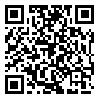BibTeX | RIS | EndNote | Medlars | ProCite | Reference Manager | RefWorks
Send citation to:
URL: http://ijdld.tums.ac.ir/article-1-5308-en.html

 , Farshad Farzadfar1
, Farshad Farzadfar1 
 , Niloofar Peykari1
, Niloofar Peykari1 
 , Bagher Larijani *
, Bagher Larijani * 
 2, Shadi Rahimzadeh3
2, Shadi Rahimzadeh3 
 , Ehsan Rezaei-Darzi1
, Ehsan Rezaei-Darzi1 
 , Sahar Saeedi Moghaddam4
, Sahar Saeedi Moghaddam4 

2- 1. Non-Communicable Diseases Research Center, Endocrinology and Metabolism Population Sciences Institute, Tehran University of Medical Sciences, Tehran, Iran ,
3- 4. Department of Epidemiology, Shahid Beheshti University of Medical Sciences, Tehran, Iran
4- 5. Department of Biostatistics, Faculty of Paramedical Sciences, Shahid Beheshti University of Medical Sciences, Tehran, Iran
Background: Thyroid cancer is the most common form of endocrine cancer. The age and gender-adjusted incidence of thyroid cancer has increased faster than that of any other malignancy in recent years, with the increased incidence seen in both genders, all ethnic backgrounds and all sizes of thyroid cancer. It appears that the rise in thyroid cancer incidence is not only due to medical surveillance and improved disease detection. In Iran, also scattered studies had been accomplished in different provinces and requirement to more attention and planning for thyroid cancer. Thyroid cancer’s control and prevention requires to the evidence–based strategies in different population groups based on national and provincial comprehensive studies on the prevalence and incidence. Thus we aimed to provide the comprehensive information about thyroid cancer prevalence and trend in national, provincial levels among Iranian population.
Methods: In this study we used some steps respectively to show how thyroid cancer prevalence changes in 1990 to 2010 between different provinces. We aggregate cancer registry data set by province, age categorized, gender and merge with other national covariates that were gathered in Iran. Then, linear regression model and logistic regression model were used to modeling and predicting for other provinces and years.
Results: Mean of thyroid cancer prevalence displayed that prevalence increased with increase in years especially more rapidly from 2002-2010 the prevalence rates were estimated to be (0.0-0.25) and (4.2-13.7) per 100000 in 1990 and 2010 respectively and increased in both females and males. Female to male ratio was 2.5. Highest prevalence thyroid cancer were in four provinces of Iran, Isfahan (mean rate 4.3 per 100000), Yazd (mean rate 4.1 per 100000), Tehran (mean rate 4 per 100000) and Qazvin (mean rate 3.1 per 100000) respectively.
Conclusion: Iran map displayed with increase in years, thyroid cancer prevalence become larger. Additional research on the risk factors for thyroid cancer is needed to explain the difference of thyroid cancer prevalence between provinces.
Received: 2015/01/22 | Accepted: 2015/11/9 | Published: 2016/03/7
| Rights and permissions | |
 |
This work is licensed under a Creative Commons Attribution-NonCommercial 4.0 International License. |



